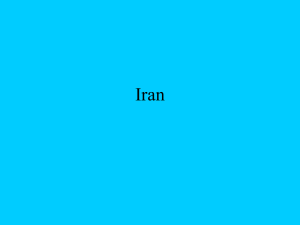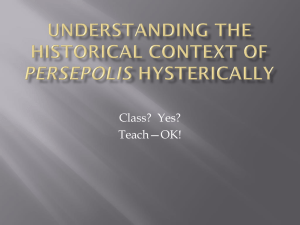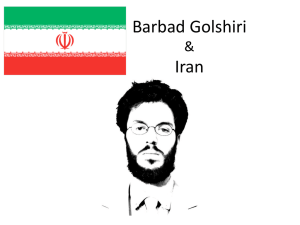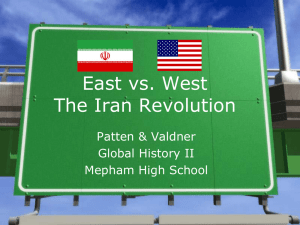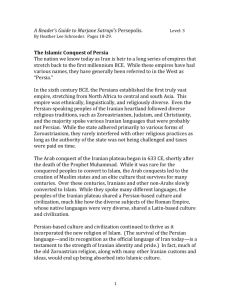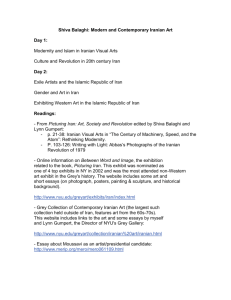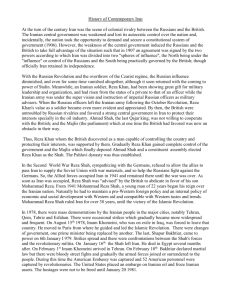The Iranian Revolution, 1978-1979
advertisement
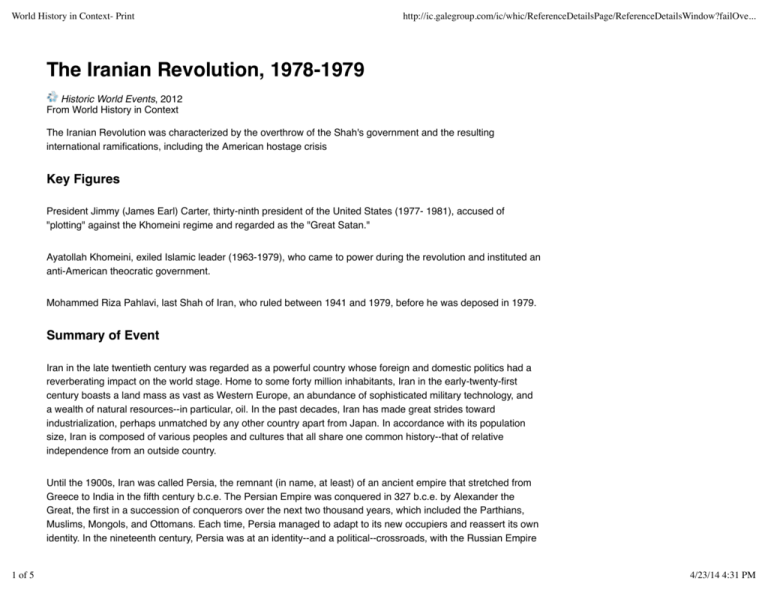
World History in Context- Print http://ic.galegroup.com/ic/whic/ReferenceDetailsPage/ReferenceDetailsWindow?failOve... The Iranian Revolution, 1978-1979 Historic World Events, 2012 From World History in Context The Iranian Revolution was characterized by the overthrow of the Shah's government and the resulting international ramifications, including the American hostage crisis Key Figures President Jimmy (James Earl) Carter, thirty-ninth president of the United States (1977- 1981), accused of "plotting" against the Khomeini regime and regarded as the "Great Satan." Ayatollah Khomeini, exiled Islamic leader (1963-1979), who came to power during the revolution and instituted an anti-American theocratic government. Mohammed Riza Pahlavi, last Shah of Iran, who ruled between 1941 and 1979, before he was deposed in 1979. Summary of Event Iran in the late twentieth century was regarded as a powerful country whose foreign and domestic politics had a reverberating impact on the world stage. Home to some forty million inhabitants, Iran in the early-twenty-first century boasts a land mass as vast as Western Europe, an abundance of sophisticated military technology, and a wealth of natural resources--in particular, oil. In the past decades, Iran has made great strides toward industrialization, perhaps unmatched by any other country apart from Japan. In accordance with its population size, Iran is composed of various peoples and cultures that all share one common history--that of relative independence from an outside country. Until the 1900s, Iran was called Persia, the remnant (in name, at least) of an ancient empire that stretched from Greece to India in the fifth century b.c.e. The Persian Empire was conquered in 327 b.c.e. by Alexander the Great, the first in a succession of conquerors over the next two thousand years, which included the Parthians, Muslims, Mongols, and Ottomans. Each time, Persia managed to adapt to its new occupiers and reassert its own identity. In the nineteenth century, Persia was at an identity--and a political--crossroads, with the Russian Empire 1 of 5 4/23/14 4:31 PM World History in Context- Print http://ic.galegroup.com/ic/whic/ReferenceDetailsPage/ReferenceDetailsWindow?failOve... in the north, British India in the east, and the Ottoman Empire in the west. The reigning leaders or shahs played one power against the other to retain their own independence as much as possible. Their strategy proved successful and indeed Persia remained free from traditional colonial rule that dominated so many other countries worldwide. However, in 1907, Britain and Russia signed an agreement, known as the Anglo-Russian Entente, which defined boundaries for shared control of the country. With the outbreak of World War I, the British established informal control of Persia out of fear that the Turks (and their German allies) might gain a strategic advantage over them. The ruling Persian dynasty, too weak to resist, signed an agreement at the war's end, allowing the British to modernize the government, the army, and the oil industry, serving, in effect, to preserve British control. This step, however, was rejected by many who were wary of foreign intervention. With a strong sentiment of nationalism, local "tribal" chiefs revolted against the central government. General Reza Khan Pahlavi, a young nationalist, staged a coup in 1921 and proceeded to reconsolidate power, overturn British contracts, stamp out regional revolts, and declare himself the new Shah of "Iran"--a native name with more traditional and patriotic connotations than "Persia." The Reza Shah set himself the goal of modernizing Iran, replacing British experts with politically powerless German ones. To achieve this, he sought to expand the oil industry by importing machinery for both industry and agriculture. Progress was slow but the interwar years allowed Iran a head start that most of the Third World, under European control, did not have. World War II brought instability to the region once again. The British now looked at Iran with increasing suspicion due to its German element. Following the Nazi invasion of the Soviet Union in June 1941, the newly allied British and Russians urgently needed a supply route in order to stave off a Russian collapse. The only feasible option was through Iran. After conducting token negotiations with the Shah, the British and Russians invaded Iran, forcing almost immediate surrender. Concerned that the Reza Shah was a Nazi sympathizer, the allies consented to Iranian independence on one condition--that he abdicate in favor of his son, twenty-two-year-old Reza Muhammed Pahlavi. The young Pahlavi became known thereafter as the Shah of Iran. The young Shah was both idealistic and inexperienced. Having been educated in Europe and familiar with (if not also sympathetic to) prevailing Western ideas, he was determined to create a modern Iran that was strong and independent. However, it was not all smooth sailing. The first twelve years of his rule were marked by many challenges. He was forced to comply with a Tripartite Treaty of Alliance with Great Britain and the U.S.S.R. for the duration of the war against the Axis. During this time, he struggled for control over the Iranian bureaucracy, despite Allied assurances giving him the reins. After the war, the U.S.S.R. retained control over a small, 2 of 5 4/23/14 4:31 PM World History in Context- Print http://ic.galegroup.com/ic/whic/ReferenceDetailsPage/ReferenceDetailsWindow?failOve... pro-Communist province, but, following the declaration of the Truman Doctrine in March 1947, Soviet forces were finally withdrawn. With international issues more relaxed, the Shah now faced domestic problems. Reactionist and radical elements demanded change and a weakening of the Shah's power. Following a 1949 assassination attempt, the Shah took advantage of his popularity and broadened his Parliamentary powers. He distributed royal lands to small landowners and continued to win support. Alarmed conservatives accused him of being a tool of the West and staged a coup d'état, forcing him out of the country for a brief period in 1953. However, the Shah, aided by the American Central Intelligence Agency (CIA), had anticipated this turn of events, preempted it, and succeeded in coming back victorious and more secure than ever. With regard to foreign policy, he employed a threefold strategy. Fearing Russian expansionism, he encouraged the United States to station military forces on Iranian soil. America responded in kind, believing Iran to be one of the "key" nations of the free world, and poured military equipment and technology into the country. His second strategy was modernization. This involved modernizing factories, promoting education, and ensuring a balanced economy. To do this, he sold Iranian oil in exchange for Western machinery and know-how. His third strategy was to plan political reform. The population was becoming less poor and more educated and the Shah hoped that he could gradually extend political freedoms and redistribute wealth to become a first-rate industrial democracy. The plan appeared to succeed for a while and each passing decade saw greater and greater industrial output and a substantial rise in per capita income. Whereas in the 1940s the number of Iranian students numbered only a few thousand, by the 1970s there were over seven million. In 1961, the Shah implemented a "revolution" of agrarian reform, seizing land from large landowners and redistributing it among tenant farmers. Political freedoms were extended, provincial governments were granted greater authority, and there were now signs of a cultural renaissance. Oil revenues, the engine behind it all, rose dramatically from $200 million in the 1950s to about $5 billion in the mid-1970s. Despite these outward successes, the Shah remained elitist, authoritarian, even ruthless. While the wheels of progress were grinding, there was a continued imbalance of wealth. Many Iranians were strongly opposed to pro-American politics, including Iran's sale of oil to Israel, which were viewed as slavishly obedient and distinctly anti-Islam. The increasingly articulate and educated population found the Shah's rigidity unsatisfactory and there were quiet murmurings of discontent. In 1978, the discontent spilled over with the exposure of widespread government corruption; riots and 3 of 5 4/23/14 4:31 PM World History in Context- Print http://ic.galegroup.com/ic/whic/ReferenceDetailsPage/ReferenceDetailsWindow?failOve... demonstrations ensued. Early that year, the Ayatollah Ruhollah Khomeini was expelled from Iraq, to where he had fled in 1963. He moved to Paris and now became the symbolic leader of the fermenting revolution. In early August, a crowded theater was burnt to the ground, killing about 400 people, and this was viewed by the public as a government attempt to frame the opposition for the deed. This sparked fresh violence. In response, the Shah gave assurances of democratic reforms and he appointed a moderate prime minister. By September, widespread dissent was evident. Industry, especially oil, experienced a large, coordinated slowdown, which caused economic instability. A month later, the economy had effectively ground to a halt. The Shah declared martial law and appointed a general as prime minister, but the unrest widened. In January 1979, the Shah was faced with two alternatives: restore order by force or leave the country. He chose to go to Egypt, perhaps hoping to return soon as he had done in 1953. The government transferred power to the conciliatory Shahpur Bakhtiar, but this was short-lived. The Ayatollah Khomeini returned from Paris and instituted his own government. The Revolution followed a troubled course. People returned to work and order was restored, but serious economic problems remained. Khomeini's leadership was uncertain, and no consensus of national purpose was forthcoming. While devout Muslims sought a return to traditional values, others wanted a more leftist government. The Shah was now living in exile in Panama and threats were made against those who had helped him. The situation came to a head when U.S. President Jimmy Carter allowed the deposed Shah to enter the United States for medical treatment. This prompted radical Iranian students to issue a takeover of the American embassy in Tehran and seize sixty-six American hostages in November 1979. The hostage crisis, which lasted 444 days, was later described as an entanglement of vengeance and mutual misunderstanding. As a significant aspect of the Iranian Revolution, it represented the turmoil and upheaval of a nation pitting change against tradition, democracy against theocracy, and East against West. Source Citation "The Iranian Revolution, 1978-1979." Historic World Events. Detroit: Gale, 2012. World History in Context. Web. 23 Apr. 2014. Document URL http://ic.galegroup.com/ic/whic/ReferenceDetailsPage /ReferenceDetailsWindow?failOverType=&query=&prodId=WHIC& windowstate=normal&contentModules=&mode=view& displayGroupName=Reference&limiter=&currPage=&disableHighlighting=false& displayGroups=&sortBy=&search_within_results=&p=WHIC%3AUHIC&action=e& 4 of 5 4/23/14 4:31 PM World History in Context- Print http://ic.galegroup.com/ic/whic/ReferenceDetailsPage/ReferenceDetailsWindow?failOve... catId=&activityType=&scanId=&documentId=GALE%7CBT2359070327& source=Bookmark&u=wildwood&jsid=23773ff7140433544a17b3bd8e6ce6fb Gale Document Number: GALE|BT2359070327 5 of 5 4/23/14 4:31 PM
